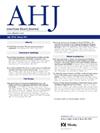Trends in urine drug screening and positivity among patients with heart failure: Insights from a large health system
IF 3.5
2区 医学
Q1 CARDIAC & CARDIOVASCULAR SYSTEMS
引用次数: 0
Abstract
Background
Substance use is common in patients with HF and affects candidacy for advanced HF therapies. Rates and results of urine drug screening (UDS) are understudied particularly in the setting of increasing decriminalization of some substances. Substance use, particularly cannabis, has been increasing in older age groups who are most at risk of HF. However, while UDS assesses substance use, no guidelines recommend routine screening for patients with HF, outside of evaluation for advanced therapies.
Methods
We performed a retrospective study including data from the Epic electronic health record of a large academic health system in Colorado. We identified 75,166 adult patients who had a UDS, of which 6,725 (8.9%) had HF or cardiomyopathy.
Results
Among patients with a UDS, any positive result was found in 64.6% for patients with HF and 56.0% for patients without HF. For patients with HF who had a UDS, the highest positivity rates were for opiates (42.4%), cannabinoids (29.0%), benzodiazepines (28.0%), and cocaine (11.0%). Patients who were tested with UDS were more likely to have HF if they were older, male, Black and were Medicare beneficiaries. Our analysis demonstrated a high rate of UDS positivity among patients presenting with HF who were tested for UDS in a tertiary care center.
Conclusion
Conclusion: Findings suggest that substance use, particularly opioids and cannabinoids, may be common in patients with HF.
心力衰竭患者尿液药物筛选和阳性趋势:来自大型卫生系统的见解。
药物使用在心衰患者中很常见,并影响晚期心衰治疗的候选性。尿液药物筛查(UDS)的比率和结果尚未得到充分研究,特别是在某些物质非刑事化的背景下。物质使用,特别是大麻,在HF风险最高的老年群体中一直在增加。然而,虽然UDS评估药物使用情况,但除了评估先进的治疗方法外,没有指南建议对心衰患者进行常规筛查。我们进行了一项回顾性研究,包括来自科罗拉多州一个大型学术卫生系统Epic电子健康记录的数据。我们确定了75,166例患有UDS的成年患者,其中6,725例(8.9%)患有心衰或心肌病。在UDS患者中,64.6%的HF患者和56.0%的无HF患者出现阳性结果。在合并UDS的HF患者中,阿片类药物(42.4%)、大麻素(29.0%)、苯二氮卓类药物(28.0%)和可卡因(11.0%)的阳性率最高。接受UDS检测的老年人、男性、黑人和医疗保险受益人更有可能患HF。我们的分析表明,在三级医疗中心进行UDS检测的HF患者中,UDS阳性率很高。研究结果表明,药物使用,特别是阿片类药物和大麻素,可能在心衰患者中很常见。
本文章由计算机程序翻译,如有差异,请以英文原文为准。
求助全文
约1分钟内获得全文
求助全文
来源期刊

American heart journal
医学-心血管系统
CiteScore
8.20
自引率
2.10%
发文量
214
审稿时长
38 days
期刊介绍:
The American Heart Journal will consider for publication suitable articles on topics pertaining to the broad discipline of cardiovascular disease. Our goal is to provide the reader primary investigation, scholarly review, and opinion concerning the practice of cardiovascular medicine. We especially encourage submission of 3 types of reports that are not frequently seen in cardiovascular journals: negative clinical studies, reports on study designs, and studies involving the organization of medical care. The Journal does not accept individual case reports or original articles involving bench laboratory or animal research.
 求助内容:
求助内容: 应助结果提醒方式:
应助结果提醒方式:


